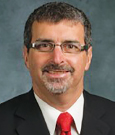Older patients with acute myeloid leukemia (AML) have high relapse rates after induction chemotherapy, low survival rates, and fewer treatment options compared with younger patients. One of the options for both younger and older patients is hematopoietic cell transplantation, but relatively few older patients undergo this potentially curative treatment for a variety of reasons.
Now, the first prospective, multicenter trial of transplants in selected older AML patients may prompt more consideration of this option. The trial has supported the findings of smaller, retrospective studies showing that a modified, less aggressive transplant regimen in the elderly appears to significantly improve survival. Two years after first complete remission in this nonrandomized phase II trial, survival rates were over 40%—twice as high as expected based on historical data.
We have shown this to be “an effective strategy for suitable older patients with an available matched donor,” concluded the authors, led by Steven M. Devine, MD, who directs the Blood and Marrow Transplant Program at the James Comprehensive Cancer Center, The Ohio State University. Carried out jointly by the Blood and Marrow Transplant Clinical Trials Network and the Transplant Committee of the Cancer and Leukemia Group B (CALGB)—now the Alliance for Clinical Trials in Oncology—the study was recently published in the Journal of Clinical Oncology.1
The new data could play a role in the crucial decision-making process that comes in AML once the patient has had induction therapy and reached first complete remission. At this point, physicians and their older AML patients have several general options to consider, including standard consolidation chemotherapy; a trial of one of the many new and combination chemotherapies under study; or the modified transplant regimen for those who are eligible, either on or off trial.
“I still don’t know which is better, but the data are intriguing and changing in favor for transplant,” said Syed A. Abutalib, MD, Assistant Director, Stem Cell Transplant & Cell Therapy, at the Midwestern Regional Medical Center, Cancer Treatment Centers of America, commenting on the cooperative group study. “Transplant is a solid option.”
Slow Increase in Use
In younger patients with AML, transplant involves high-dose chemotherapy to condition the bone marrow, ie, eradicate leukemia cells, before infusing the body with healthy donor stem cells. In younger patients, these stem cells can be autologous, derived from the patient’s own marrow, or allogeneic, ie, from healthy donor stem cells. Both the high-dose conditioning regimen and the allotransplant procedure are risky for patients aged 60 years and older. But starting in the early 2000s, small studies began to suggest that with reduced-intensity conditioning and allogeneic donors, fit older patients could tolerate and benefit from transplants. Based on those findings, the clinical guidelines of the National Comprehensive Cancer Network now recommend that patients aged 60 and older, “who are deemed strong candidates for stem cell transplant and have an available donor should be transplanted in first remission.”2
Oncologists and their older patients have not flocked to the transplant option, however. The potential toxicity of even reduced-intensity conditioning and the difficulty of knowing which patients are “strong candidates” for transplant are two related and important reasons. Other factors—medical, logistical, financial, and social—also come into play.
“It’s a difficult discussion,” said Harry P. Erba, MD, PhD, Professor of Medicine and Director of the Hematologic Malignancy Program at the University of Alabama, Birmingham (UAB). “There are many factors to consider other than outcomes data from clinical trials.”
Possibly because of these uncertainties and concerns, relatively few transplants take place in older AML patients. The number has risen somewhat since 2000, according to data from the Center for International Blood and Marrow Transplant Research. But it has been estimated that only an estimated 6% of the elderly patients diagnosed with AML each year undergo transplants.3
Transplant Trials
The CALGB trial enrolled 114 patients between the ages of 60 and 74 years with a median age of 65. All patients were in first complete remission after induction therapy, and all received reduced-intensity conditioning (fludarabine followed by busulfan [Busulfex]), at half the strength used in younger patients. The transplanted hematopoietic cells were from HLA-matched related or unrelated donors. Patients also took tacrolimus and methotrexate to help reduce the risk of graft-vs-host disease.
Two years after transplant, 42% of patients were cancer-free, an apparent improvement compared to only about 20% of similar patients who had received consolidation chemotherapy in prior CALGB trials.
The trial’s results are bolstered by preliminary findings from a larger, randomized trial, the AML 2004 East German Study Group (OSHO) trial, presented in abstract form⁴ at the 2014 American Society of Hematology Annual Meeting and Exhibition by Dietger Niederwieser,
MD, of the University of Leipzig. In that phase III trial, the relapse rate at 2 years was 79% in older AML patients who received consolidation chemotherapy vs 40% in those who received a transplant after first complete remission. The leukemia-free survival rate at 8 years was 32% on the transplant arm compared to 13% on the chemotherapy arm.
Other transplant trials in older AML patients, listed in the National Institutes of Health database, clinicaltrials.gov, are underway in the United States and Europe.
Issues in Decision-Making
While clinicians and their older AML patients now have more data to use when considering a transplant, issues remain.
“When I talk to my patients, I tell them that the chance of relapse appears to be lower with transplant than with any other postremission option,” said Dr. Erba. “But it is also clear that the magnitude of the benefit is greatest in specific subsets of patients. So we look at other factors.”
One of those factors is age. A key message from the CALGB trial is that physiologic age is more important than chronologic age when deciding about transplant, Dr. Devine said. “We consider patients for transplant even in their 70s if they have a reasonable performance status and are reasonably fit,” he said.
But how to determine reasonable fitness is still a gray area. A high ECOG performance score is often used along with an assessment of comorbidities. Some programs are exploring supplementary methods, such as frailty assessments and/or using surveys done in the clinic during appointments, Dr. Devine said.
None of these approaches is completely reliable, however, and patient selection is “always a big issue,” he said. “In future trials,” he added, “we need to look at how to do a better job of assessing fitness.”
Prognostic Markers
Also important in selecting patients for transplant are prognostic biomarkers. Patients with core binding factor (CBF) translocations, for instance, are at lower risk for relapse and therefore may not need a transplant in first remission. This is particularly true if they also do not have the molecular markers that have been associated with a worse prognosis, such as the FLT3 or KIT mutation. Furthermore, patients with translocation 8;21 and inversion 16 are particularly sensitive to chemotherapy and often respond to salvage therapy at the time of relapse.
“The leukemia doctor will consider such prognostic biomarkers, assessing the patient’s chances of a cure with chemotherapy or the need for a transplant,” said Dr. Erba.
These and other biomarkers are expected to play an increasingly larger role. “We need to understand more about how the mutational status of a patient with AML determines response to various therapies including transplantation,” said Dr. Devine. “That is, certain patients may do better with transplant vs conventional therapy, and certain patients may not even do well with transplant and require novel approaches.”
Logistics
Other issues that can affect the choice of transplantation are logistical. One of them is the need to find a matched, allogeneic donor. The CALGB study originally was limited to sibling donors, but the protocol was changed as it became clear that among elderly patients, sibling donors were often not available. Accrual rates rose when the protocol was amended to allow unrelated donors, and in the final results, there were no significant differences in outcomes between patients with related and unrelated donors.
The transplant field has recently developed alternative sources, including cord blood and haploidentical donors. As a result, said Dr. Erba, “a suitable donor can be found for most AML patients.”
But it still takes time, and the entire process—initiation of HLA typing and identification of donors—can stretch over several months. Ideally, the search for a donor should begin early, while induction therapy is still underway, say experts.
“A strong message from [the CALGB study] is that patients should be considered for transplant early in the course of the disease to determine if they are potential candidates,” said Dr. Devine.
And transplant and leukemia doctors should cooperate early in that process, Dr. Abutalib said.
That is less an issue in large medical centers with active transplant programs, such as UAB. “When we admit a patient who is a potential transplant recipient,” said Dr. Erba, “we do HLA typing and have them seen by the transplant team. If I have a patient who is a potential candidate for transplant, I get the transplant team involved as soon as possible.”
But in community cancer centers, the patient may not be referred to a transplant center for evaluation until after remission. This delay can reduce the chances of finding a donor in time, since remissions after induction therapy are often brief, especially in older patients.
Social Issues
There are also a variety of social issues that potential transplant patients, along with families and physicians, have to consider. One of these is insurance. At UAB, for instance, there are many uninsured patients, Dr. Erba said. “We scramble to get them Medicaid or charity care, but it takes time, and time is of the essence.”
Perhaps even more difficult for some potential transplant patients is the requirement that they have a caregiver at home, 24 hours a day, 7 days a week, for at least 3 months after coming home from the hospital. Transplant patients are at high risk for graft-vs-host disease, and opportunistic infections during this period have to be monitored closely. But many elderly patients live alone or with a partner with other health problems; their families may be geographically scattered. Without a suitable caregiver, transplant is not an option.
“Finally, quality-of-life issues should always be part of these discussions with patients,” Dr. Erba said. “I tell my fellows that they should understand the goals of their patients for this time of their lives.” Patients who are deciding between chemotherapy and transplant have to weigh the chance of cure vs the impact of treatment in terms of their own goals. “If they want to live to see a baby born, due in 6 months, then chemotherapy might be the best choice. If it’s most important to them to see a grandson graduate from college 6 years from now, they might opt for the transplant.”
Despite the numerous factors that make the decision a complex one, researchers are buoyed by the new data and the prospect of more.
Looking forward, one important area of research is maintenance of remission, Dr. Devine said. Although consolidation chemotherapies and transplants prolong remission, most patients relapse eventually. So development of candidate maintenance therapies is an urgent need.
“One of my hopes is that we can work collaboratively with our leukemia colleagues on a trial of strategies to further reduce relapse rates,” he said. ■
Disclosure: Dr. Devine has received research funding from Genzyme. Drs. Abutalib, Erba, and Niederwieser reported no potential conflicts of interest.
References
1. Devine SM, Owzar K, Blum W, et al: Phase II study of allogeneic transplantation for older patients with acute myeloid leukemia in first complete remission using a reduced-intensity conditioning regimen. J Clin Oncol 33:4167-4175, 2015.
2. National Comprehensive Cancer Network: Acute myeloid leukemia, version 1.2015. Available at www.nccn.org. Accessed December 11, 2015.
3. Ustun C, Lazarus HM, Weisdorf D: To transplant or not: A dilemma for treatment of elderly AML patients in the twenty-first century. Bone Marrow Transplant 48:1497-1505, 2013.
4. Niederwieser D, Al-Ali HK, Krahl R, et al: Higher leukemia free survival after post-induction hematopoietic cell transplantation compared to consolidation therapy in patients >60 years with acute myelogenous leukemia (AML): Report from the AML 2004 East German Study Group (OSHO). 2014 ASH Annual Meeting. Abstract 280. Presented December 8, 2014.





